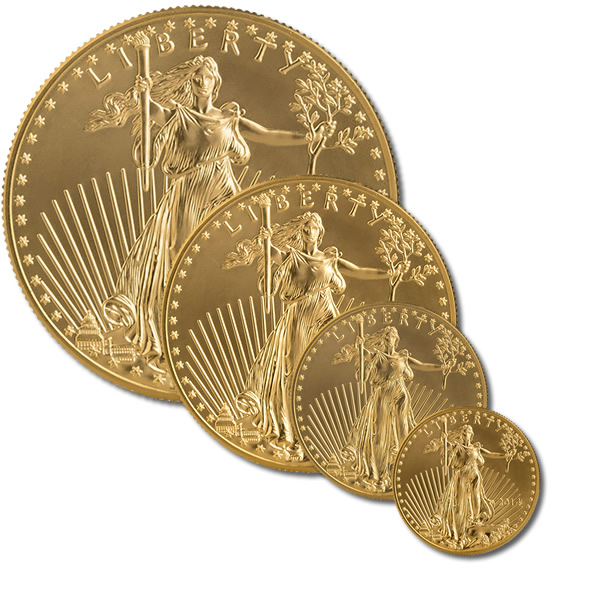


The American Gold Eagle is a very attractive coin with a strong patriotic image. It’s also a convenient and cost effective way of adding gold to your investment portfolio. Like any other precious metal investment, though, investing in Gold Eagle coins is a lot more effective if you arm yourself with some knowledge first. It’s not a complicated subject so you can quickly pick up all you need to know. This guide will be enough to get you started.
The Gold Eagle is available in four different sizes. The standard coin weighs one troy ounce; its design shows a figure of Lady Liberty on the face and an eagle on the reverse. Three smaller coins are also produced to the same design; these weigh ½oz, ¼oz and 1/10oz.
In many ways Gold Eagles are similar to gold bars as an investment medium. They’re available in a variety of sizes and the purity of the gold is fixed. Many of the same factors also affect how you should invest in them.

There are many different producers of silver bullion bars and, like any other product, their prices will vary. Some mints charge more of a premium over spot price than others. If your plan is to simply buy as much silver as possible you'll probably want to avoid those and seek out mints with a low premium. On the other hand bars with a high premium usually also have a higher resale value. That might not always be true in the future, but if you're planning a short term investment it's something you might want to consider.
Because they are officially issued by the US government these coins are legal tender and each size is marked with a face value on the reverse side. These values are $50 for the 1oz coin, $25 for the ½oz, $10 for the ¼oz and $5 for the 1/10oz. The coins can legally be used to pay any debt at their face value. In practice this is never done, because their actual worth is far higher due to the gold content. This has always been the case; when the coins were first introduced in 1986 the gold spot price was over $300 per ounce, but the 10z coin had the same $50 face value as today.
Just like bullion bars, Gold Eagles carry a premium above the actual spot price of gold because of the work required to produce them. This premium disproportionately affects the smaller coins because while their gold content is less than the larger ones the work involved in making them is essentially the same. Therefore if you’re aiming to add the largest possible amount of gold to your portfolio the 1oz coin is the most efficient investment, with the other sizes becoming progressively less efficient as size decreases. On the other hand the smaller ones offer an advantage in terms of divisibility; if you only hold 1oz coins, but want to sell ½oz of gold, you have a divisibility problem. If you think that’s a likely scenario your best option is to purchase the bulk of your stock in 1oz coins but add a selection of smaller ones to allow flexibility.
The West Point Mint produces Gold Eagles in three distinct grades. The standard version is the bullion coin. These are intended for investment and are produced through a standard coin process; polished gold coin blanks are inserted into a die and struck once, stamping them with the pattern. The bullion coins are available in all four sizes and are by far the most common Gold Eagles. However there are two further grades.
Uncirculated coins are intended for collectors. They are produced in the same way as the bullion coins, but are distinguished by the letter W (for West Point) stamped below the date. After stamping they are sealed into protective plastic capsules and mounted in presentation cases. The packaging adds an additional small price premium. For investment purposes these coins are less efficient than bullion coins; the packaging is purely decorative and adds nothing to their intrinsic value. Uncirculated coins are generally only available in the 1oz size.
Proof coins are a further collector grade. These are finished to a higher standard – the coin blanks are burnished to a very high gloss then struck multiple times in the die. The result is a mirror finished background field and a frosted appearance on the raised details, making them extremely attractive items. Again they have the W mark. Like the uncirculated coins they are sealed in plastic and mounted in presentation cases. Proof coins are available in all four sizes and also in a box set containing one of each size. There is a further small price premium and again they are less suitable as an investment medium.
Although different finishes are used, all three grades are made from the same metal. Gold Eagles are, by law, made only from gold mined in the USA. The alloy used is 22 karat – 91.67 percent gold, 3 percent silver and 5.33 percent copper. This makes them harder than pure gold coins and less vulnerable to damage. It also brings them up to the Crown gold standard, rather than the earlier standard used for US gold coins which contained only 90% gold.
Uncirculated and proof Gold Eagles can be bought directly from the United States Mint. Prices are usually updated weekly to reflect the London gold price. However it’s the bullion coins that are more relevant to investors and these are not sold by the mint. Instead they can be bought from most bullion or coin dealers. They are also extremely easy to sell both in the USA and worldwide.
The Gold Eagle is a good choice if you want to add gold to your portfolio; it’s flexible, has only a small premium above the spot price and is recognized globally as a useful investment vehicle. Because its purity and weight are tightly regulated by the US government it’s also easy to understand – unlike bullion bars there is a fairly small range of options available and few of them make a major difference to the value of each coin. This combination of simplicity and dependability make for an attractive purchase.
Next Page → : Silver Eagle Buying Guide